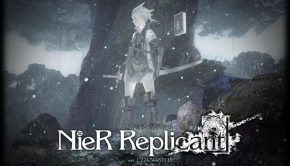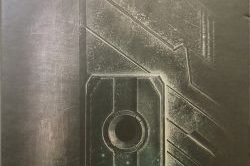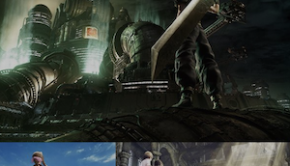John Graham Interview: Scoring Kingsglaive
John Graham recently composed the soundtrack to Kingsglaive, the film prologue to the upcoming Final Fantasy XV. While Graham isn’t new to the Square Enix scene, this is his largest assignment with them to date. A major part of his role in composing for the film was to separate the storyline from that of the game, and create a standalone soundtrack.
In this email interview, Graham discusses how he came to be on board with Kingsglaive, and the process behind composing for the film. While the film’s soundtrack, which can be purchased on iTunes, is not related to the upcoming game, his tracks are alongside those of Final Fantasy XV composer Yoko Shimomura, who also contributed to the film. Graham also worked closely with director Takeshi Nozue to create a distinct musical setting for Kingsglaive.
Interview Credits
Interview Subject: John Graham
Interviewer: Emily McMillan
Editor: Emily McMillan
Coordination: Beth Krakower
Interview Content
Emily: Thank you so much for speaking with us over at VGMO! How did you come to be on board with Kingsglaive?
John Graham: I worked on a couple of shorter projects for Square Enix and was impressed with how just plain positive the vibe is there; people are all helping each other, cheerfully trying to make the end result as good as it can be. So, naturally I was hoping to do more work with them, but even so I was stunned when they invited me to score the movie – stunned in a good way!
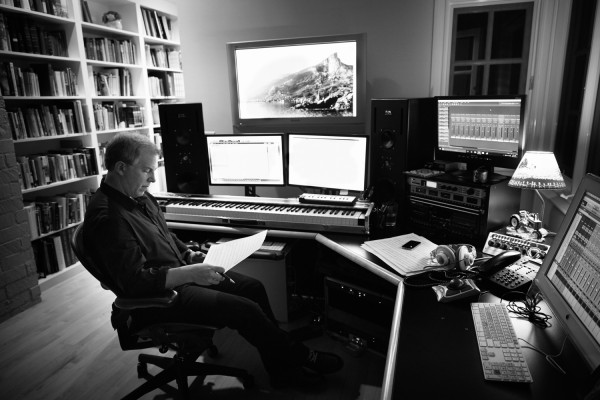
Emily: Did you face any challenges or reservations working on a score that has a game counterpart and an anime counterpart scored by three other composers?
John Graham: It would have been easy to get tangled up in Final Fantasy’s almost thirty year world, with such a large body of fans and an equally large body of musical and artistic material behind it.
From the start, however, Takeshi Nozue, the director, asked for music that would be very specifically and particularly conceived for Kingsglaive. The movie is its own story; yes, it inhabits the space of Final Fantasy and is of course part of that, but you can watch the movie without any previous experience of the characters or story and still follow it and enjoy it for its own sake.
Put another way, the goal was to make sure the movie had the music it needed and was asking for, rather than to lace it with references to other parts of the FF world. I am very grateful for the creative scope that offered – I find movies more or less tell you what music they need.
Emily: Were you and Yoko Shimomura in contact during the making of the film? Although your music is separate from the upcoming Final Fantasy XV game, the main theme and some of the cues in the film came from her. How did you integrate your music with hers?
John Graham: To integrate the sound of the score, we recorded almost all of it in the US, with the superb Daniel Kresco recording, engineering, and mixing everything. We also worked to integrate the orchestration and arranging to make sure the score sounded cohesive throughout, adding electronic and other elements to some cues, which I think made for consistency and balance. Of course, the director also supervised the process along with his music team.
Emily: One pairing of themes that I especially enjoyed was her track “Luna” with your “Kings of Lucis,” which both heavily utilize strings. “Luna” is much lighter and more delicate, whereas “Lucis” uses strings in a much lower range.
(Editor’s note: Graham was originally credited as the composer of “Kings of Lucius”; however, this has since been changed to credit Yoko Shimomura for the track)
John Graham: Actually, Yoko wrote “Kings of Lucis” but, to answer your question, we did change the arrangement to add scale, make it darker and more serious in line with the rest of the score in this section of the film, and to add power.
Emily: You’ve said that you video conferenced with Kingsglaive director Takeshi Nozue to touch base on composing for the movie. What kind of information did you get during those conferences to influence your music?
John Graham: I worked with Takeshi, the director, from Los Angeles, communicating by email and some video conferences with him and his team. He had a very clear idea of what he was looking for, and also what he didn’t want. For example, he wanted to avoid a feeling of “techno” or heavily electronica or dance styles in the score, and from the start wanted the orchestra to be the mainstay. That said, there are thousands of electronic parts in the score – warped and twisted organic sounds, pulses, deep “threatening” elements, and sound design parts that are purely electronic. Overall, the sound we were going for remains essentially organic and natural, in keeping with the emotional vibe of the story, even though it also has a lot of synths and electric guitars in places.
Emily: Why was Nozue-san against pop or electronic music in particular? It seems like a very specific request. Had it been suggested earlier on in the process, or was he trying to take the movie in a specific direction?
John Graham: You’re right – it is very specific! And for me, it made sense for two main reasons. First, the movie is about real people caught up in extraordinary circumstances – how they react, what they lose, their courage or cowardice, their adherence or abandonment of duty – all that. That stuff is fundamental to human beings, whether it’s happening in the distant past or in modern times. Second, although there is also modern technology in the movie, one of the key matters at issue is magic, including the crystal that guards Lucis. Without giving away the story, you learn over time that the magic is complex, ancient, and subject to rules that are not apparent immediately. In fact, those rules don’t necessarily even follow a modern notion of right and wrong, and they are certainly not always benign. The magic acts somewhat like fate, or inevitability or something like that.
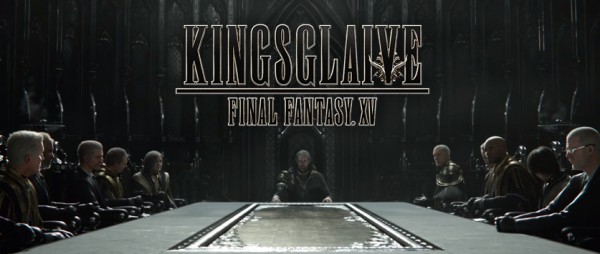
So to reflect both the very human, emotional aspect of the story and the ancient, almost unknowable mystery of the magic, it makes sense to centre the sound of the music on the sounds of the orchestra that have in general been around for thousands of years – banging things that go “boom” and rattle, scraping bows across strings, and using wind instruments that don’t differ fundamentally from what we can see in some of the oldest drawings and friezes known to humans.
Even where we did use electronics, many of the electronic elements begin with a recorded organic sound – a real thing being scraped, beaten, shaken, or blown into – and then tortured a bit to make them sound the way we wanted.
So overall, it’s an organic score, even with the electronic elements. While I think it makes sense to use the vocabulary of modern scoring which includes electronic sounds, I think Takeshi’s inclination fits the emotional core of what the movie is about.
Emily: You were able to work with the Nashville Music Scoring Orchestra to record the soundtrack. When did you learn that you would have access to a live orchestra, and how did it affect your composition?
John Graham: That is a very insightful question, because if you don’t know at the outset whether you’ll have an orchestra, you have to write differently, and not in a good way! In this case, it was always planned to use a large orchestra to replace the sampled orchestral parts of the score. In fact, one of the best parts of this project was that, from the start, the goal was clearly to produce the best possible sound, and the producers went out of their way to make that happen. We were able to hire superb musicians led by Alan Umstead, an amazing score producer in Koyo Sonae, our brilliant engineer Daniel Kresco, and our superb conductor and orchestrator, Eric Schmidt. Not only did we have plenty of fine musicians to play the score, the team that worked together to record and mix the final recordings was excellent as well.
Emily: When saw more of the completed film, you ended up changing some of your music to match the new visuals. Which tracks in particular did you have to go back and revise, and what was it about those scenes that motivated revision?
John Graham: The “Battle for the Crown City” changed a lot, from first viewing. A lot changed with this scene as the artists and editors revised it, but probably the most dramatic change was its lighting. The first time I saw the scene I pictured a brightly lit, full-daylight scene, but the final version was much darker and more intense-looking. Much more dramatic and cooler! But it’s far from a cheerful battle, as it’s terribly destructive and – without giving away what happens, it’s fair to say there is a lot of loss.
Musically, I thought the final version of the visuals demanded more intensity than I’d originally pictured, with even greater scale and harsher sounds than the first sketch. I made the percussion even bigger than it had been originally, added more distorted guitars, beefed up the low end strings, and laid on the low brass heavily as well. There are three bass trombones doubling the low brass in this track, plus tons of drum tracks, played with crazy intensity by percussionist MB Gordy, who recorded with us at Remote Control to really beef this up.
Emily: After seeing so many sketches and pieces of the film, what was it like to see your score finally paired with the completed product?
John Graham: I worked night and day on this for months, barely sleeping for weeks on end, and I’m really proud of the result. But the great thing for me about Kingsglaive is that the final result reflects the work of thousands of people – animators, art and costume designers, actors, writers, lighting specialists, directors, motion capture experts, translators, finance people and drivers – the list is enormous. So, yes, I love hearing the music in context for a scene like “The General and the King,” fully mixed in a big theatre, but, if anything, I’m even more excited to experience the work of so many other people coming together. Sometimes I think it’s a miracle when a movie with so many elements comes to the finish line!
Emily: Do you have a favorite moment or track in the score, or a scene that was particularly fun to compose for?
John Graham: It’s always fun to write for the high points, and one of those is in “At Struggle’s End,” when Nyx fights a climactic battle against a powerful adversary. At a moment like that, everything has to be working: the music, the story, the actors, the animation and lighting. The orchestra (especially the legion of French Horns we used!) really delivered, and the final animation is dazzling. It’s also great fun for me to support the scene melodic material that’s been developing throughout the score, because at this point it has a different context altogether than at any previous point.
Emily: What else would you like to tell us about your experience working on Kingsglaive?
John Graham: I know I already talked about a high point, but there’s another favourite – “Monster Bots” when the super-powerful weapons make their appearance. This piece is all about raw power and sound – huge drums, and plenty of them! I love moments like that in film, when you are about as far from the traditional orchestra in some ways as possible, and yet you are using all its power and intensity in a different way!
Posted on September 29, 2016 by Emily McMillan. Last modified on September 29, 2016.


